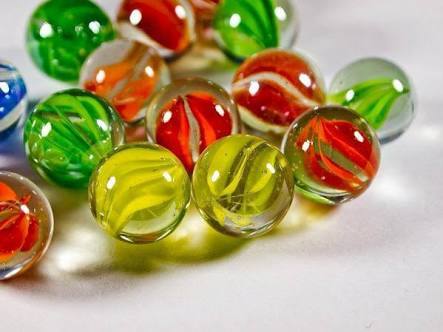Who wants some glass marbles?
 You roll 2 fair, six-sided dice, and will be given as many marbles as the sum of the two numbers you roll. What is the expected value of the number of marbles you get?
You roll 2 fair, six-sided dice, and will be given as many marbles as the sum of the two numbers you roll. What is the expected value of the number of marbles you get?
The answer is 7.
This section requires Javascript.
You are seeing this because something didn't load right. We suggest you, (a) try
refreshing the page, (b) enabling javascript if it is disabled on your browser and,
finally, (c)
loading the
non-javascript version of this page
. We're sorry about the hassle.
2 solutions
A quicker solution comes from invoking linearity of expectation . Do you see how?
Log in to reply
Yes, I just found that. I didn't think it would be linearly calculated at first.
Log in to reply
Here, it is somewhat clear that you should be able to add the expectation of each dice roll because the two dice are independent, so we get 3 . 5 + 3 . 5 = 7 .
Where linearity of expectation gets really powerful is that it applies even when the variables are not independent!
Log in to reply
@Eli Ross – Yes, that's really useful. :)
@Eli Ross – Help How does the expectation of dice roll become 3.5?
Log in to reply
@Aanchal Shahi – Each number on a die has equal probability of 6 1 .
So expected value = 1 ( 6 1 + 2 + 3 + 4 + 5 + 6 ) = 3.5
The denominator is 100%, so it may not be written.
[(1+2+3+4+5+6)]/6 + [(1+2+3+4+5+6)]/6 = 21/6 +21/6 = 42/6 =7
There are 6 × 6 = 36 ways that the dice number can turn, and here are the possible outcomes for each specific number:
2 pips: 1 way (1+1 only)
3 pips: 2 ways (1+2 or 2+1)
4 pips: 3 ways (1+3, 2+2, 3+1)
5 pips: 4 ways (1+4, 2+3, 3+2, 4+1)
6 pips: 5 ways (1+5, 2+4, 3+3, 4+2, 5+1)
7 pips: 6 ways (1+6, 2+5, 3+4, 4+3, 5+2, 6+1)
8 pips: 5 ways (2+6, 3+5, 4+4, 5+3, 6+2)
9 pips: 4 ways (3+6, 4+5, 5+4, 6+3)
10 pips: 3 ways (4+6, 5+5, 6+4)
11 pips: 2 ways (5+6, 6+5)
12 pips: 1 way (6+6)
It is clear that for x pips and 14-x pips, the possible combination is the same, so except for 7 pips, we can get common factors of 14 before diving by 36 to get the probability, P for each event (pips) X .
Hence, the expected value of glass marbles = ∑ P X = 3 6 1 4 ( 1 + 2 + 3 + 4 + 5 ) + 3 6 7 × 6 = 3 6 7 × ( 3 0 + 6 ) = 7 .